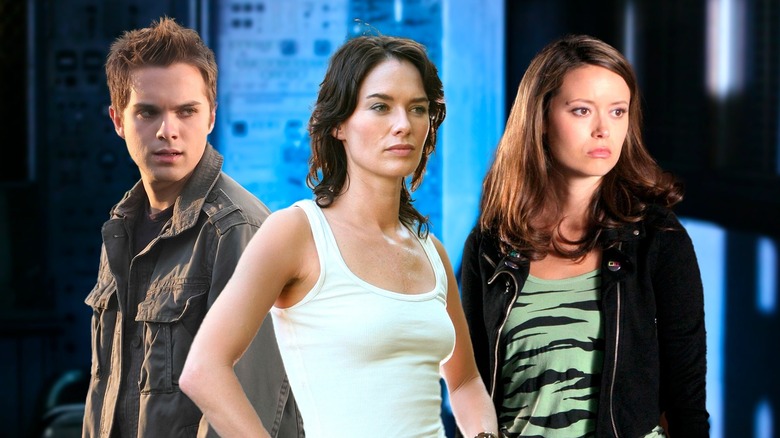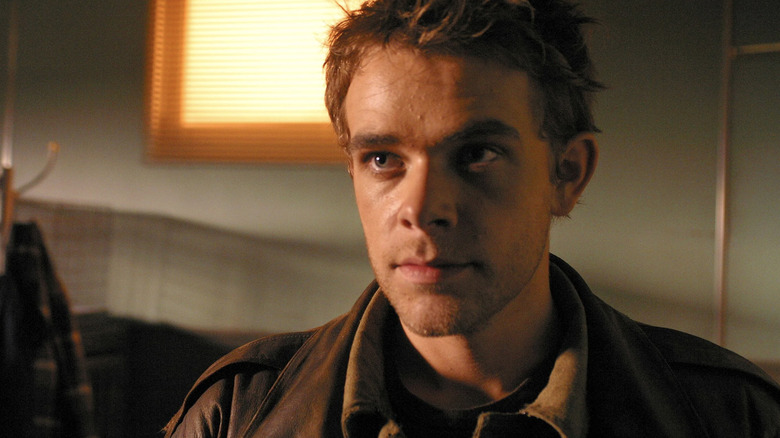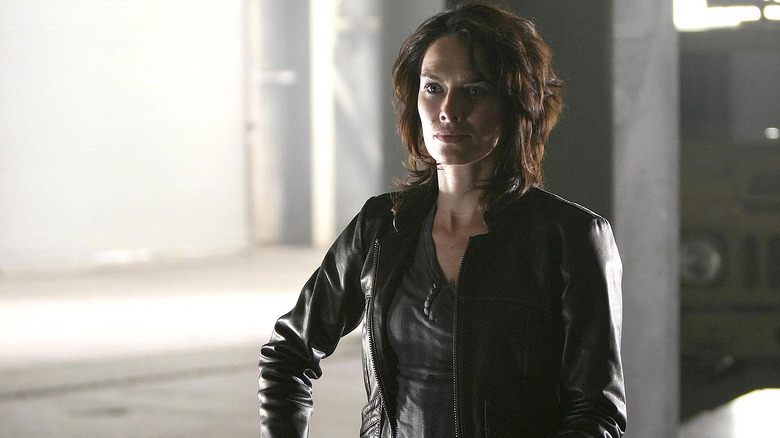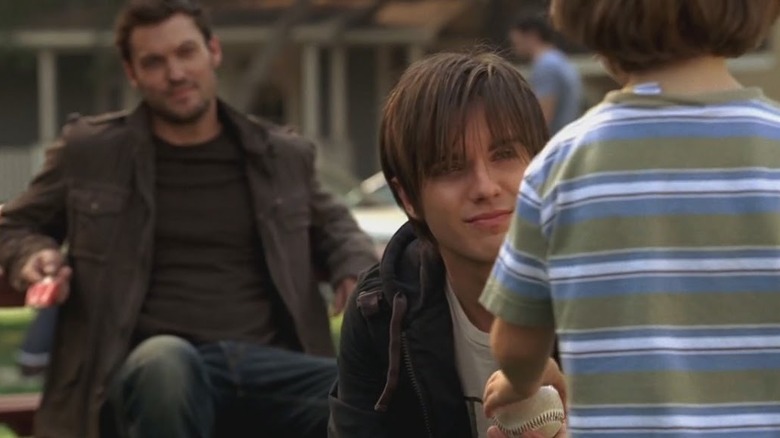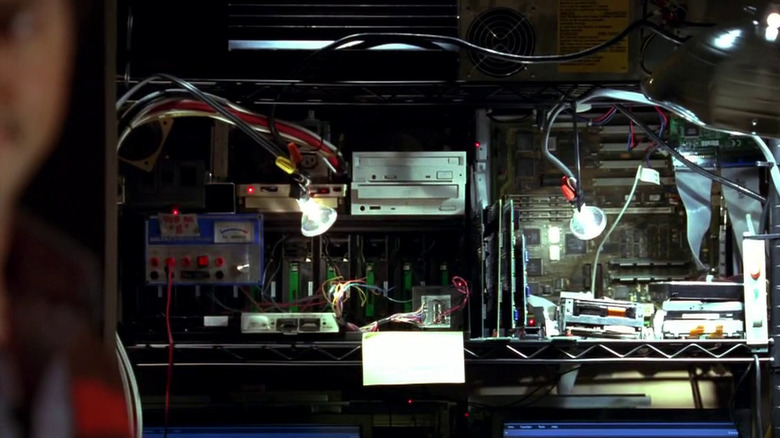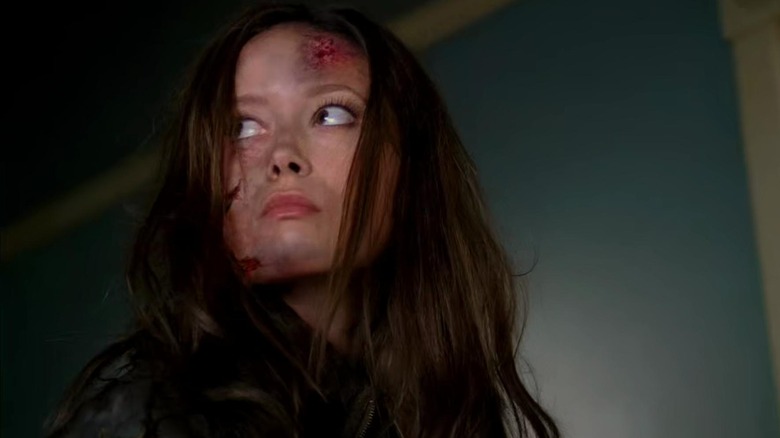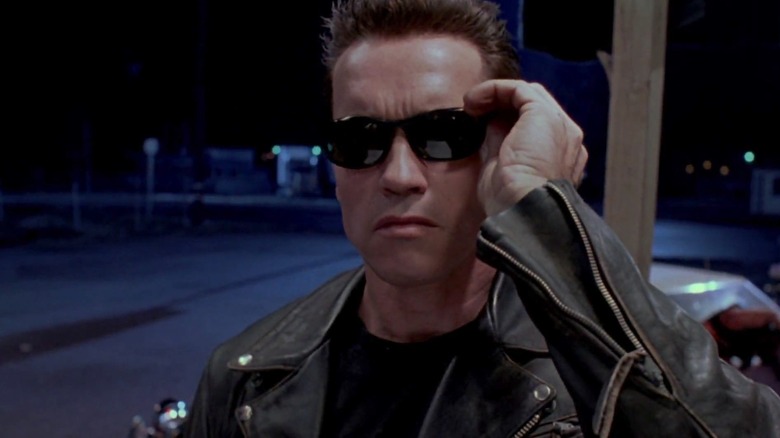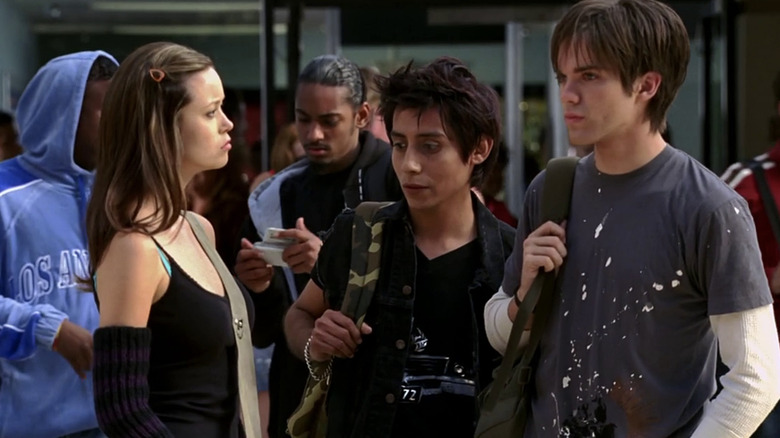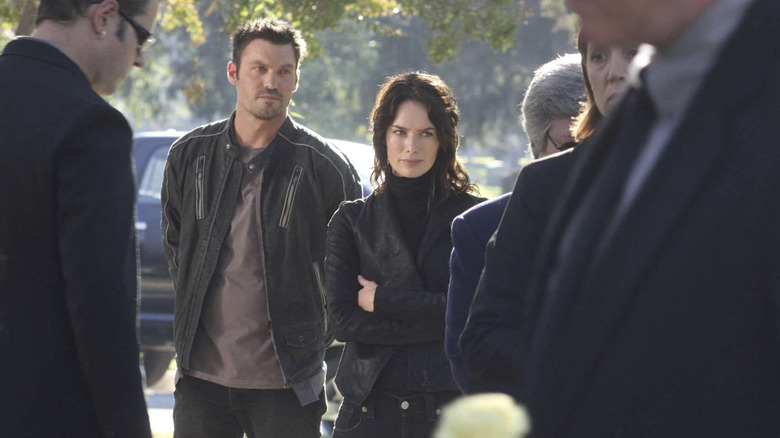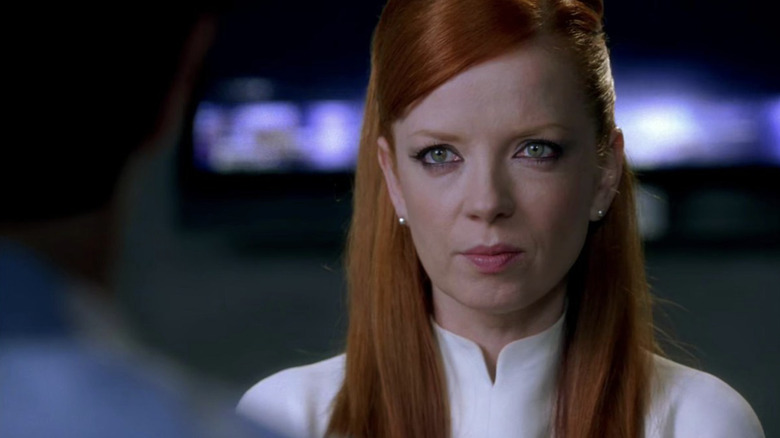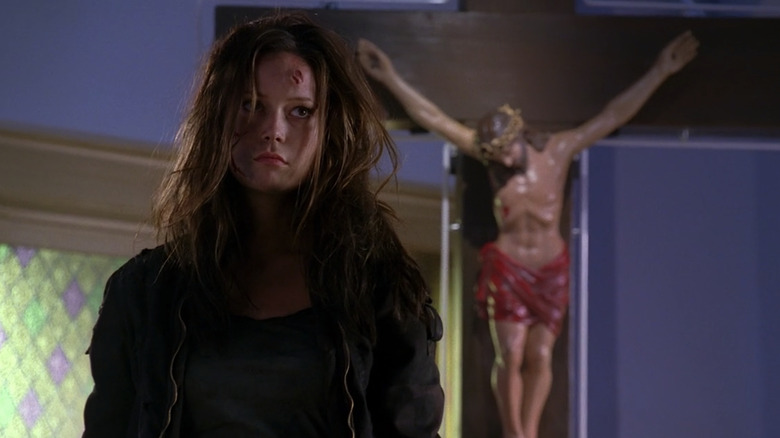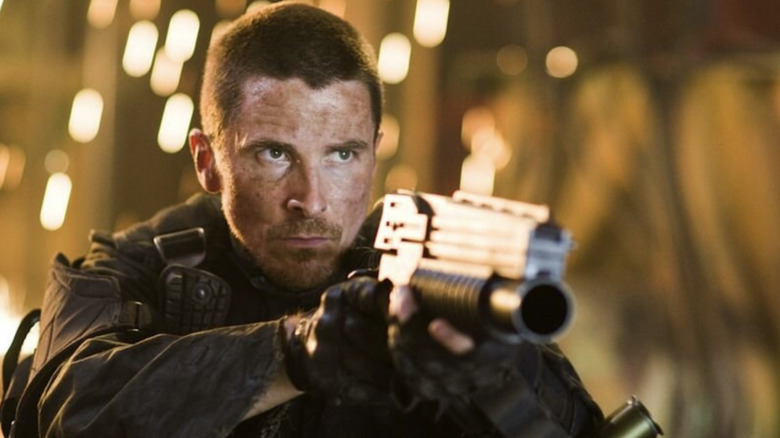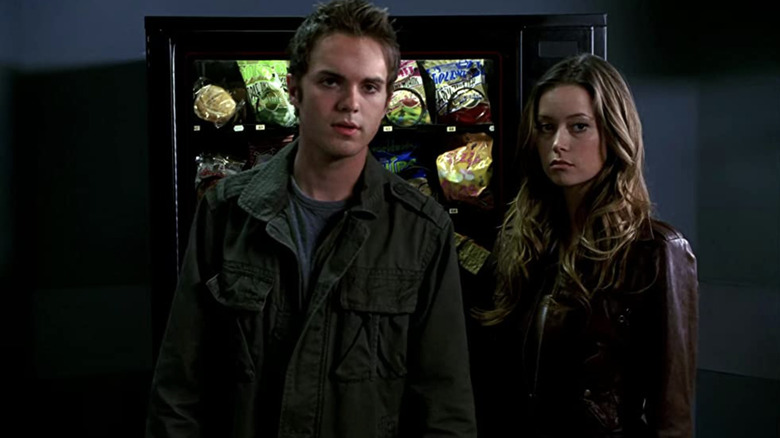Terminator: The Sarah Connor Chronicles: 12 Facts About The Series Worth Investigating
After James Cameron's first "Terminator" film in 1984, the possibilities felt endless. Just a few years later, Cameron's 1991 follow-up, "Terminator 2: Judgment Day," was released, and ever since the franchise has been fighting to catch up. Four sequels have been released since "T2," and only half of them are any good (we'll let you decide which ones you prefer), but one thing's for sure, the "Terminator" universe found new life on television in the form of "Terminator: The Sarah Connor Chronicles."
First premiering on Fox at the height of the WGA writer's strike of 2007 and 2008, the series' first season only consisted of nine episodes, but it was enough to keep the Lena Headey-led series afloat another year. Despite multiple fan-led campaigns to bring the series back, it doesn't look like the story will ever continue beyond the series' final episode — but that doesn't mean there isn't still an audience. Though the series was short-lived, "The Sarah Connor Chronicles" has amassed a cult following, and with so little "Terminator" content out there at the moment, it's an exciting series to revisit. Even if you've watched the series before, here are some facts about "Terminator: The Sarah Connor Chronicles" that will have you joining the Resistance to battle Skynet — or whatever rouge A.I. is out there.
The series skips over Terminator 3
Before the release of "Terminator: The Sarah Connor Chronicles," the live-action branch of the franchise was largely relegated to theatrical releases. James Cameron's first two pictures had done well at the box office, with "Terminator 2" quickly regarded as one of the greatest action flicks ever made. In 2003, "Terminator 3: Rise of the Machines" was released, effectively ending the series with the advent of Judgment Day — or at least that's what many thought. Though another sequel would be released half a decade later, "The Sarah Connor Chronicles" shifted the franchise to television.
"TSCC" picks up in 1999, with Sarah (Lena Headey) and John Connor (Thomas Dekker) living on the run. With the help of Summer Glau's time-traveling Terminator affectionately named Cameron, the trio jumps forward in time to 2007 — just four years before Judgment Day is destined to occur. Not only does the film generally ignore the events of "T3," acknowledging only the James Cameron films as canon, but it literally skips over the events of the third film, set four years before the series premiered. In fact, the show effectively repurposes the arc that John (played by Nick Stahl in "Rise of the Machines") works through in "T3," slowly turning the teenage boy into the future leader of the human Resistance. Dekker's performance as John is arguably the best interpretation of the character, with more screen time than any other.
Sarah never smokes, and there's a reason why
In "Terminator 2," Linda Hamilton's Sarah Connor is an avid smoker who turns to cigarettes to calm her nerves and ease her demons. She's seen lighting a cigarette a few times in the film, a habit she likely picked up as a result of her time with Kyle Reese (Michael Biehn) in the original, and this habit eventually led to her off-screen death between the second and third films. Though "Terminator: Dark Fate" shows us an aged Sarah, "Terminator 3" proclaims the action hero dead after suffering from leukemia. In "Terminator: The Sarah Connor Chronicles," Lena Headey's Sarah Connor doesn't smoke at all.
In fact, she mentions more than once that she has given up smoking altogether. The series hints that the reason Sarah quit was related to what Cameron has said about her eventual death. The Terminator tells Sarah that she dies of cancer sometime before Judgment Day, leaving John alone and vulnerable as a result. More than likely, this is another way for the series to "skip over" the events of the third film.
Of course, there are other reasons why Sarah doesn't smoke on "TSCC," most notably due to the TV censors. According to IndieWire, Warner Brothers — the studio behind the series — adopted a "no smoking" policy in 2005, just two years before the series premiered on Fox. Probably not a coincidence.
Small continuity errors confirm an alternate timeline
From the get-go, "Terminator: The Sarah Connor Chronicles" claims to follow the events of the first two James Cameron films. Though "T2" was released in 1991, it's set a few years later in 1995 to keep in line with Edward Furlong's John Connor supposedly being 10 years old. No, we don't buy it either. Not only does Furlong's John act more like a newly minted teenager, but he looks the part too. To further complicate things, "Terminator 3" mentions that John was 13 during "T2," which doesn't match up with his 1984 conception.
By the time "The Sarah Connor Chronicles" aired, the series aged John up a few years, making him 15 in 1999 and stating that it had been two years since the events of "T2." This means that in the series timeline, they faced the T-1000 in 1997. John's age is a constant question throughout the "Terminator" franchise, but even within "The Sarah Connor Chronicles'" own continuity, there's plenty of room for debate. In the episode "Today Is The Day, Part 2," John states that he was 12 during the events of "T2," thus contradicting what we learn in the "Pilot."
When you do the math, "The Sarah Connor Chronicles" version of John was probably conceived in 1983, a full year before the events of "The Terminator." Whether those events happened earlier in the timeline or not, it's clear that the show only loosely followed the specifics of the original Cameron films.
The Turk was named after an actual device
Early on in the series, Sarah learns about a device known as "the Turk," an A.I. chess-playing program that Cameron claims will eventually grow into Skynet. Throughout the rest of "The Sarah Connor Chronicles," the Turk plays a large part in the series' greater mythology. Created by Andy Goode (Brendan Hines), other companies and tech agencies became interested in the device, prompting Sarah to attempt to destroy it. Soon after, Derek Reese (Brian Austin Green) killed Andy, later revealing that he and Andy were friends in the future.
While the Turk is a fictional A.I. system, it was named after a very real hoax invented by Wolfgang von Kempelen in the late 1700s. Hoping to impress an Austrian empress, von Kempelen created a "chess-playing device" that housed a professional chess player inside, creating the illusion of a self-playing automaton. The Turk traveled the world for nearly a century before it was officially exposed as a fraud. In the series, Goode explains that he wanted to create something real, and thus chose the name for his A.I. in hopes that it might redeem it. Sadly, the series ended before the Turk could be explored any further, but its strange connection to this 18th-century ruse makes it a unique addition to the "Terminator" universe — even if it is also fictional.
Cameron's model number is unclear
One of the biggest mysteries surrounding "Terminator: The Sarah Connor Chronicles" is the addition of Summer Glau's Cameron, a Terminator sent back in time to protect and guide a young John Connor before Judgment Day. When Cameron reveals herself in the "Pilot," she flashes blue eyes as opposed to the classic Terminator red, leading some to believe that she was nothing more than a revised T-X as seen in "Terminator 3: Rise of the Machines." Of course, Cameron is so much more than that, but her exact model is still a bit of a mystery.
In the official Series Bible, Cameron is said to be a T889-F, just a model above the show's iconic T-888s (pronounced "Triple 8s"). However, the "Terminator Taxonomy" section of the official "Terminator Vault" deems Cameron a T-900, making her an alternate timeline counterpart to the T-X seen in "T3." To make things even more complicated, promotional material for the series referred to her by the Class TOK715 distinction, directing many to believe that her series and model numbers might be different units entirely, similar to how Arnold Schwarzenegger's Terminator was simultaneously referred to as a T-800 and a Model 101 unit. No matter which model number she falls under, the series highlights that Cameron is not like other Terminators.
The Governator
A fan-favorite episode of the series, the "TSCC" episode "Self Made Man" spent time exploring exactly what Cameron does while the Connors sleep. Given that she's a machine who doesn't need the same sort of upkeep as a human being, she frequently finds herself on separate missions of her own. In this episode, it's revealed that a T-888 was sent back to kill the governor of California before Cameron defeated the machine. Coincidently, the Governor at the time was none other than original "Terminator" star Arnold Schwarzenegger, often jokingly called "The Governator" based on his role in the movies.
Less than six months after the release of "Terminator 3: Rise of the Machines," Schwarzenegger took office after Gray Davis was recalled. The actor held his office firmly until 2011 when he reached his term limit, sending him back to Hollywood. Only a few years after his term, Schwarzenegger starred in the reboot "Terminator Genisys" and later returned for "Terminator: Dark Fate." Because of his political office, the former action star missed out on both the television series and "Terminator Salvation," as they were both produced during his tenure as the Governator, though his likeness was used in the latter anyway. Admittedly, Cameron saving California's governor was as close to having Arnold Schwarzenegger on the series as the show ever got, but the storyline still a fun nod to the franchise's roots.
Dropped plotlines and characters
Like any series still finding its legs, "Terminator: The Sarah Connor Chronicles" wasn't above having a host of dropped plotlines and characters who disappeared after an episode or two. The most obvious examples are John's high school friends Morris (Luis Chávez) and Cheri Westin (Kristina Apgar). While Morris' exclusion makes sense when you consider that Sarah pulls John out of school after the first season, Cheri's is a bit more disappointing given her romantic interest in John. But more than that, Cheri is in duress during her final appearance.
Before she exits the series for good, Cheri implies that her father is into some bad stuff before being whisked away from John. Unfortunately, the teenage Connor never looks into her disappearance further, and her father's possible connections to Skynet or some other sinister organization are forgotten. Paired with the Cheri plotline was a strange event occurring at John's school involving a young student and a faculty member. Though it's implied that Cheri might have been involved in the scandal, no answers are ever discovered.
Likewise, Sarah's nosy neighbor, Kacy Corbin (Busy Philipps), never shows her face at the Connor household again after the birth of her son. Although Sarah helps her through the labor process, Kacy disappears from the series entirely after "Brothers of Nablus." While the character was no doubt busy with a newborn, the series makes a point to highlight Sarah's paranoia of having a cop living next door before dropping it completely.
The show was filmed on the same set as Gilmore Girls
When we catch up with the TV versions of Sarah and John Connor, they go from hiding out in the middle of nowhere Nebraska to the middle of nowhere New Mexico. Given their need for a remote desert location, the "Pilot" was actually shot largely outside the Albuquerque area before the Connors returned to Los Angeles for the remainder of the series. Once Fox picked up "The Sarah Connor Chronicles," the show moved production from the Land of Enchantment to the Warner Bros. backlot in Burbank, where the series would reside until its eventual cancellation.
After "Gilmore Girls" wrapped production, "The Sarah Connor Chronicles" took over the space that once belonged to the fictional Connecticut town of Stars Hollow. While it may be hard to tell at times — that's the beauty of "movie magic," erm, "TV magic" — episodes of both shows were shot in the very same place. The connection between the worlds of "Terminator" and "Gilmore Girls" is especially noticeable in the Season 2 episode "Desert Cantos," where the Connors crash a funeral held in the small town of Desert Canyon, which looks suspiciously similar to Lorelai and Rory's hometown. Though sadly there was never an official crossover between "TSCC" and "Gilmore Girls," there were a few behind-the-scenes.
Shirley Manson is a real-life rockstar
Known as the T-1001 posing as Catherine Weaver, Shirley Manson's first major acting role was on "Terminator: The Sarah Connor Chronicles," though you wouldn't know it. Not only does the actress perform her part masterfully, making us fully believe that she is a machine attempting to act human, but she's multi-faceted, using her vocal talents on the series' soundtrack. Before "TSCC," Manson was the lead singer of two different Scottish rock groups: Goodbye Mr Mackenzie and the short-lived Angelfish. After that, she crossed the pond to join the Madison, Wisconsin-based Garbage.
In the years between the band's fourth and fifth studio albums, "Bleed Like Me" and "Not Your Kind of People" respectively, Manson ventured into acting and joined "Terminator: The Sarah Connor Chronicles" during the show's second season. Debuting in the season premiere "Samson & Delilah," Manson also lent her vocals to the series, performing a rock cover of the gospel song of the same name. Appearing in 17 episodes of the series, Manson's work as Weaver is her definitive acting role. No other Terminator ever sounded so good. Beyond "TSCC," she has also appeared in "Knife Fight" and the animated series "Top Wing," though her acting career has mostly fizzled out.
Christianity plays a critical role
While the "Terminator" franchise has always felt biblical, "The Sarah Connor Chronicles" took it to an entirely new level with the introduction of FBI Agent James Ellison, a new character played by Richard T. Jones, himself a devout Christian. A man of faith, Ellison holds to a code based on the Bible. The series plays upon various biblical themes, and in the latter half of the series, Ellison teaches the A.I. John Henry (Garrett Dillahunt) ethics, explaining that though mankind is made in the image of God, A.I. creations are made in man's image.
The series plays with issues of faith in a few different ways, showing that while Sarah generally rejects faith, it isn't even within Cameron's programming to understand it. In 2009, Christianity Today ran a piece titled "Jesus and the Terminator," chronicling the ways in which the franchise, including "TSCC," retells the Gospel story. "Just as the birth of Christ took place against the backdrop of a cosmic war in which the final outcome was never really in doubt, so too the birth of John Connor is soaked in the blood of battles he is destined to fight." Likewise, musical choices such as Johnny Cash's "The Man Comes Around," which evokes images from Revelation, and Shirley Manson's cover of "Samson & Delilah" reflect the series' religious undertones. In many ways, it's impossible to separate "Terminator" from Christianity, and "TSCC" leans the hardest into it.
It ended just before the release of Terminator Salvation
Thinking that they would be renewed for a third season, "Terminator: The Sarah Connor Chronicles" ended on April 10, 2009, just under two months before McG's "Terminator Salvation" premiered in theaters. Though you'd assume that the studio would take advantage of two "Terminator" productions overlapping, aside from attempting to coordinate DVD releases, the studio failed to capitalize on the free promotion. Sadly, "TSCC" was canceled just weeks prior to "Salvation's" release, despite attempts by fans to save it. From then on, Warner Bros. put all its "Terminator" eggs in the "Salvation" basket.
Although the series was canceled for lack of viewership, "Terminator Salvation" did well at the box office. The film was set in the post-apocalyptic world of 2018 and followed Christian Bale's John Connor. Given how "The Sarah Connor Chronicles" ended, "Salvation" is almost cathartic as we watch John engage in the Future War in a world post-Judgment Day. Of course, "Salvation" is technically a sequel to "Terminator 3" and was meant to be the start of a new trilogy, but like "The Sarah Connor Chronicles," those plans were axed too. Evidently, "TSCC" served as an omen, signaling the quick decline of the franchise.
Plotlines were reworked into future Terminator movies
Though "The Sarah Connor Chronicles" ends on a pretty massive cliffhanger, series creator Josh Friedman has vowed never to reveal how the show would've ended. Although folks at the now-defunct SaveTheSCC tried on multiple occasions to convince the network to revive the series, Friedman has moved on. "To give some sort of finite, canonical opinion on what would be (and always is) a much more fluid, dynamic situation seems sort of stultifying for all the people who have invested emotionally in the show," he told Clique Clack in 2012. "It wouldn't just be killing it for me, it would be killing it for them. This way it's sort of Schrödinger's TV show."
Since the series' cancellation, some concepts and ideas from the show have made their way into other "Terminator" mediums. In the reboot film "Terminator Genisys," Emilia Clarke's Sarah Connor shares similarities to Dekker's John from the series, including a battle against his own destiny. Likewise, Danny Dyson and a young Kyle Reese are highlighted in "Genisys," echoing moments from "The Sarah Connor Chronicles" — as well as potential plans the show had for Danny (Shawn Prince). But Friedman wasn't finished with "Terminator" after "TSCC." In 2019, he received a story credit on the James Cameron-produced "Terminator: Dark Fate." Though the film was a box office bomb, it dealt with multiple timelines and possible futures and further humanized machines through love interests, building on the groundwork laid by "Terminator: The Sarah Connor Chronicles" years prior.
